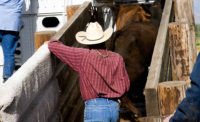2016 Food Safety Report
The very fabric of food safety in the meat industry
Apparel that helps diminish the spread of contaminants in meat and poultry plants has become more prevalent and popular.

It is important for operators to have guidelines for cleaning and sanitizing workplace apparel, as well as a definition of the clothing styles permissible for employees.
Meat and poultry plant operators typically give the bulk of their attention to machinery and work surfaces in their quest to eliminate pathogens from facilities. While such areas are key sources of bacteria, a narrow focus on the spaces can blind producers to other potential sources of contamination.
That includes the prospect of workers transporting pathogens into plants and contaminating foods via their clothing and uncovered body parts. While giving attention to the proper apparel and related sanitary practices can help eradicate incidents, operators often minimize the importance of such elements.
“The meat industry is not putting as much emphasis on clothing as it should,” says Angela Fraser, associate professor of food safety in the department of Food, Nutrition and Packaging Sciences at Clemson University in Clemson, S.C. “There is a need to study the roles that workers’ clothing plays in contamination in food production settings.”
The Society of Food Hygiene and Technology (SOFHT), a Middleton, U.K.-based consortium of food industry specialists seeking to improve hygiene throughout the food chain, agrees that proper apparel is crucial to food safety.
“The importance of the correct protective clothing policy cannot be over emphasized,” the SOFHT states, noting workers are a major potential source of both foreign body contamination — from such elements as hair, skin scales, threads and buttons — and microbial contamination.
“It is essential that operatives working in the food and related industries are aware of this risk and wear the appropriate clothing in the food production area,” the SOFHT reports.
Time to give apparel its due
To minimize the threat of foodborne illness, meat and poultry operators need to manage apparel as they would other frequent areas with bacteria, such as tainted tables and floors, Fraser says.
“Apparel can serve as a vehicle for transmitting pathogens from one source to another,” she says. “Workers can contaminate their hands by touching dirty clothing. Yet, many plants regard apparel like the elephant in the room by not seeing or treating it as a possible source of contaminants.”
The ideal protective gear is disposable, non-absorbent, single-use coverings, such as plastic aprons or overcoats, Fraser says. Some plants, however, either do not require such items or limit their use because of cost concerns and a desire to reduce waste.
“Many businesses struggle with the trade-off of making foods safer versus contaminating the Earth,” she notes.
Alternatives to plastic include cloth overcoats and uniforms. But it is important for operators to have guidelines for cleaning and sanitizing such apparel, as well as a definition of the clothing styles permissible for employees.
“Workers’ sleeves should be about three-quarters length so that the employees can easily wash their hands,” Fraser says. “Plants also should consider prohibiting workers from wearing watches or bracelets as the items can serve as barriers to washing.”
Mandates on the specific apparel that workers must or cannot wear typically varies among facilities, says Mike Govro, technical scheme manager for certifications programs for NSF International, an Ann Arbor, Mich.-based food safety auditing firm and standards developer.
A plethora of potential safeguards
While hair nets, beard snoods, disposable and reusable gloves, smocks and arm sleeves that cover the wrist to the elbow are common, some operators also require workers to wear booties over their shoes.
Other safety protocols include having employees change into sanitized uniforms after arriving at plants and to exchange their personal shoes with “captured” footwear that does not leave the plant, such as rubber boots, Govro says.
“You never know the environment from which workers entering a plant are coming,” he says. “They could have just changed dirty diapers at home or been working in a cow pasture. It is important for plant operators to have some level of control.”
Many plants develop guidelines for apparel and associated food-safety procedures after undergoing risk assessments or by following Global Food Safety Initiative (GFSI) recommendations. The GFSI is a worldwide movement to improve food management systems, including food safety. Participants include retailers, manufacturers, food services companies, international organizations, governments, academia and service providers.
The NSF, meanwhile, often requires operators to verify the effectiveness of their apparel laundering and cleaning procedures as part of its meat plant audits. Elements can include authentication of the washing time, temperature and detergents that companies use to clean uniforms, and conducting periodic lab tests to check bacteria levels.
“There are many bacterial concerns in the different stages of meat operations, ranging from handling carcasses through processing,” Govro says. “It is important to implement controls that are relevant to the nature of the product and the workers’ activities.”
A wonderful world of color
Other possible measures that have proven to enhance food safety include requiring employees to wash their hands before using disposable gloves and mandating glove changes after workers handle a broom or other potential sources of pathogens, he says.
Protein producers also can help minimize cross-contamination by color-coding employee apparel in accordance with their work areas. Such actions enable operators to pinpoint personnel who, for instance, cross from a processed meat to a raw meat section without changing into sanitized outfits, SOFHT reports, adding it is particularly prudent to use color coding for “high care” and “low risk” areas.
Apparel, meanwhile, is likely to become more sophisticated as meat plant operators seek additional methods for eradicating the spread of foodborne illnesses, Fraser says, noting that elements might include the use of Teflon-like coatings to prevent contaminants from absorbing into — or clinging onto — fabrics.
Plant operators and workers also will gradually become more aware of the need to scrutinize apparel for cleanliness, Govro says.
“There is growing acceptance by companies and their employees of the importance of wearing the proper clothing for food safety,” he says. “There was once, for instance, a lot more grumbling by workers about having to wear hair nets instead of baseball hats, but attitudes are changing.” NP
Looking for a reprint of this article?
From high-res PDFs to custom plaques, order your copy today!









